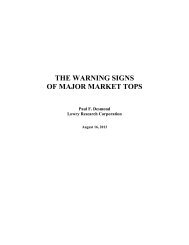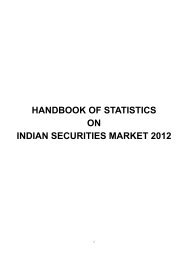1 |
april2016
april2016
Create successful ePaper yourself
Turn your PDF publications into a flip-book with our unique Google optimized e-Paper software.
Up… Down… Up… Down… Repeat<br />
Markets rise and fall in cycles, and while many try to predict the exact nature of these cycles and when they start and end,<br />
things don’t always work out exactly as they did before. That being said, markets move in trends and counter-trends, each<br />
of which can exist over the short-term, mid-term and long-term time frames.<br />
My Beliefs<br />
• Markets experience up waves of optimism, followed by down waves of pessimism.<br />
• Owning stocks in uptrends makes far more sense than owning stocks in downtrends.<br />
• An uptrend is defined by higher lows and higher highs.<br />
• A downtrend is defined by lower highs and lower lows. • Stocks can fall far more than you would ever think<br />
fathomable.<br />
• Owning stocks during a bear market is akin to financial suicide.<br />
• Small losses are preferred to big losses.<br />
• Emotions + investing don’t mix well.<br />
• I like companies that make money, and preferably can boast large growth in earnings.<br />
• I don’t like debt. I have none myself, and I prefer my investments to have modest debt/equity ratios.<br />
• Liquidity can be a major issue in the markets. It’s important to ensure that the market is sufficiently liquid for<br />
your participation. I prefer to be able to liquidate positions in under 10 minutes.<br />
• Investors should increase their risk when markets are in a clear uptrend.<br />
• Investors should eliminate their risk when the markets are in a clear downtrend.<br />
• Cash with no return should be preferred to falling equity prices.<br />
• Total Return is far more important than dividends alone.<br />
• Total Return = Dividends + Capital Gain/(Loss)<br />
• Dividend-paying “blue-chip” stocks can experience significant losses and should not be considered “low risk”.<br />
• A stop loss is an important part of any serious investment discipline.<br />
• When the average investor is scared of the markets, investors should be looking for opportunities and consider<br />
buying stocks.<br />
• When the average investor is complacent and BNN/CNBC are bullish, I get nervous.<br />
• Buying stocks on pullbacks provide great risk to reward and is a generally less risky practice than buying<br />
breakouts.<br />
• Most investors could be much more successful if they limited their losses on bad investments.<br />
Constructing a portfolio of investments that offer above-average opportunity for return on a risk-adjusted basis should be<br />
the goal of most investors. In countless discussions with my clients, prospects, family and friends, one common wish is<br />
9 | TECHNICALLY SPEAKING APRIL 2016




